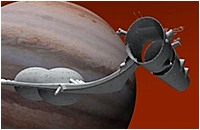TTA: Unidentified: Object 4
 Early in 2088 a Perimeter Beacon in the Proxima system signalled the approach of an artificial object that refused to acknowledge requests for identification, and two security ships were dispatched to investigate. Within a few hours they had made visual contact and it was immediately apparent that the ship did not originate from known space . It was an enormous construction which dwarfed the Proximan craft and was obviously designed to carry living beings of some kind. That parts of the interior were illuminated could be seen through the hundreds of apertures in the hull, but none of the Proximan's various signals were answered in any way. It was decided that the alien vessel was either empty or disabled as its course would take it into the sun.
Early in 2088 a Perimeter Beacon in the Proxima system signalled the approach of an artificial object that refused to acknowledge requests for identification, and two security ships were dispatched to investigate. Within a few hours they had made visual contact and it was immediately apparent that the ship did not originate from known space . It was an enormous construction which dwarfed the Proximan craft and was obviously designed to carry living beings of some kind. That parts of the interior were illuminated could be seen through the hundreds of apertures in the hull, but none of the Proximan's various signals were answered in any way. It was decided that the alien vessel was either empty or disabled as its course would take it into the sun.
Assistance was called for and when it arrived lines were attached and the craft towed into a stationary orbit round Proxima One. It was certainly a bizarre object, made more so by its prodigious size, and unlike any spacecraft ever seen. Scientific teams from all three systems set up temporary research stations to study it and to attempt communication with any passengers it may have had. When all attempts failed it was decided to force entry, upon which the craft was found to be entirely deserted. That it had been equipped for life forms of some kind was easily determined from the nature of the internal fittings and equipment, but whatever these beings were like, it is doubtful that they were humanoid.
Although it has been possible to identify many of the craft's features, much remains a mystery even after nearly twenty years of study. It is known, for instance, that the basic power source was nuclear fission, and that the equipment operated on similar principles to that in current use. Also, the two massive spheres forming part of the hull contained plant life of some kind, as the presence of organic debris in them indicates. These spheres were fed with a rich oxygenated atmosphere distributed throughout the ship via a network of ducts. The implication is that this represented their required atmosphere and therefore that they, like we, were a carbonbased lifeform. The hull itself appears to be organic in composition and is formed by an atrophied cellular structure. This suggests that the outer body of the ship was itself a living organism at some time. Whether this was before or during its function as a spacecraft has not been established.
One further conclusion generally accepted by the investigating teams is that the entire structure was originally attached to something else. There is a number of projections with fittings of various kinds which appear to have no obvious function other than to connect with another body of similar construction. This view is reinforced by the fact that the hull carries no engines or any other possible source of motive power. If this is the case then the complete assembly must have been an awe inspiring sight, particularly as this portion would probably have been no more than a smaller appendage of the main body.